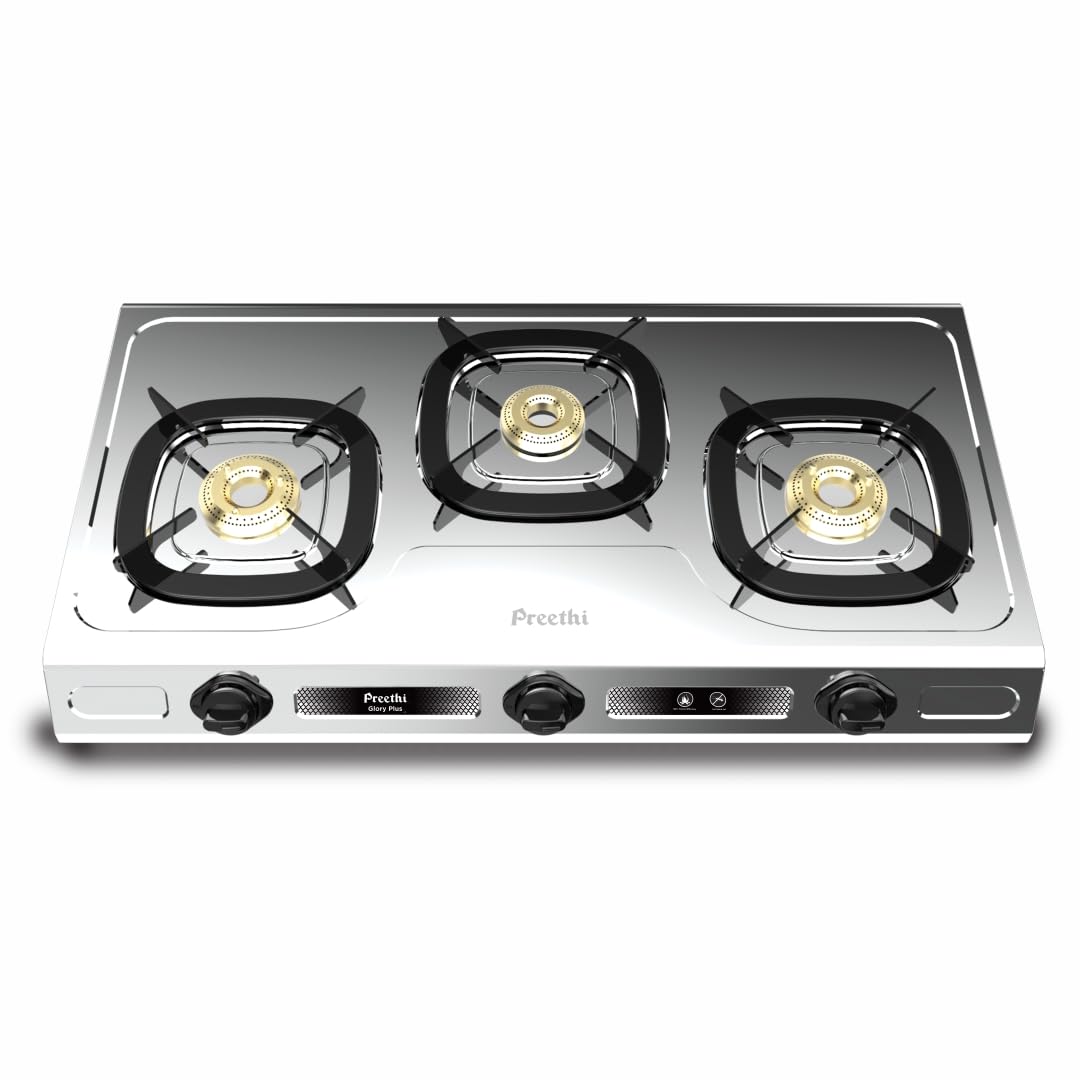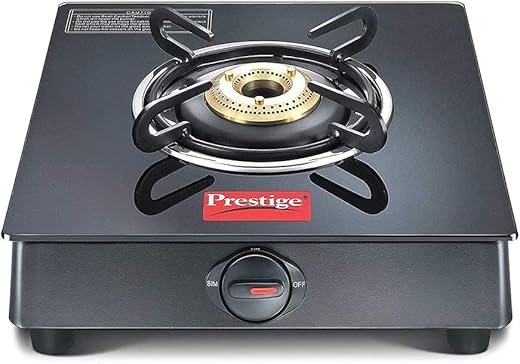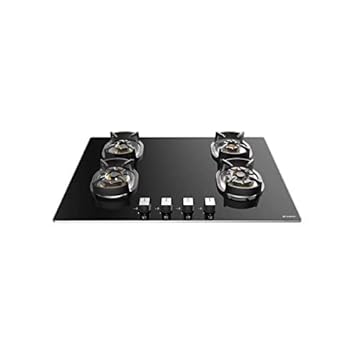Glass vs Steel Cooktop Durability: Which Top is Best?
Choosing a new cooktop often comes down to two dominant materials: toughened glass or stainless steel. While glass offers a sleek, modern aesthetic, steel promises a rugged, traditional toughness. The ultimate decision hinges on one critical factor: durability—specifically, how each material stands up to the heavy-duty demands of daily cooking.
This comprehensive guide breaks down the durability comparison to help you choose the best cooktop for your cooking style and kitchen environment.
Trending Gas Stove Deals
Prestige IRIS Toughened Glass-Top 3 Brass Burner LPG Gas Stove | Black Spill Proof Design | Ergonomic Knob | Tri-Pin...
Free shipping
- Spill Proof Design - For hastle free cooking and a Cleaner Kitchen
- Tri-Pin Burners - For high Efficiency and faster cooking
- Ergonomic Design - For easy handling and Maintainance
- Toughned Black Glass top - Resists Scratches and withstands everyday wear and tear
- 2 Years Manufacturer Warranty
Prestige Vectra 3 Burner Glasstop Gas Stove|Superior Toughened Glass|Jumbo Brass Burner|3-Way Gas Inlet|360 Degree Revolving Nozzle|10 Years Warranty on Glass|Black,open
Free shipping
- SUPERIOR TOUGHENED GLASS : The durable glass ensures long lasting good looks in your kitchen with 10 years of warranty.
- JUMBO BURNER FOR FASTER COOKING : Our signature brass burners ensure long-lasting performance and efficient use of LPG.
- 360° REVOLVING NOZZLE : Convenience of connecting hose pipe from any direction with the 360° revolving nozzle.
- GAS LIGHTER HOLDER and CLEANING STAND: Handy gas lighter holder to simplify your kitchen setup and Cleaning Stand for easy to clean gas stove bottom
BLOWHOT Premium Design Emerald 3 Burners Auto Ignition Gas Stove (ISI Certified) - 2 Year Warranty, Heavy Tornado Brass Burner,...
Free shipping
- Features uniquely designed High Power Tornado Brass Burners, frame is black powder coated and have thick glass top. This stove is ISI certified and is designed for Maximum Safety.
- DESIGNED KNOBS : Unique design knob in burner will give elegant look and enhance the beauty of the kitchen.
- TOUGHEND GLASS TOP : Toughened Glass Top along with black powder coated body makes a unique combination of strength and elegance.
Everflame Pearl 2 Burner Gas Stove ISI Certified | 5G Forged Brass Burner | Gas Saver Technology | Stainless Steel...
Free shipping
- ✅ Durable & Stylish Stainless Steel Cooktop – Built to last with a sleek, heavy-duty stainless steel design that adds a touch of elegance to your kitchen.
- Powerful 5G Forged Brass Burners – High-efficiency burners ensure even heating, faster cooking, and better fuel savings for a smooth cooking experience.
- Compact Yet Spacious Design – Smartly designed to fit your kitchen perfectly while providing enough space to cook with large utensils comfortably.
Lifelong LLGS201 Open Single Burner Glass Gas Stove (Black, 27 x 29 x 9 cm), Manual Ignition, Black
Free shipping
- Product is compatible with LPG only. Brand does not provide LPG to PNG conversion.
Khaitan 4 Burner Active Forge Red Digital Toughened Glass | LPG Gas Cooktop I Manual Ignition | Ergonomic Knob |...
Free shipping
- 6 mm Toughened Glasstop : The top body of this stove is made of 6 mm Toughened Glass. It strengthens the durability of the product. The glass is unbreakable, heat resistant and scratch proof.
- Efficient Burners - Equipped with Efficient and long lasting Brass Plated CI Burners that ensure proper heat distribution during cooking. It consumes less gas and cooks food faster. It has Brass Valves.
- Bakelite knobs - This Manually Operated Gas Stove Comes with Smoothly Operated, Ergonomically Designed, Heat Resistant Bakelite knobs.
The Durability Face-Off: Glass Top vs. Steel Top Cooktops
The table below summarizes the key durability characteristics based on how each material reacts to heat, impact, and wear over time.
| Feature | Glass Top Cooktops (Toughened Glass) | Steel Top Cooktops (Stainless Steel) |
| Impact Resistance | Moderate. While toughened/tempered glass is strong, it is vulnerable to cracking or shattering from heavy, sharp impact (e.g., dropping a full pressure cooker or a heavy utensil). | Excellent. Highly resistant to impact. Can withstand heavy cookware and accidental drops without cracking, though heavy force may result in dents. |
| Thermal Shock | Good, but a risk. Excellent heat resistance for normal cooking, but vulnerable to breakage from sudden, extreme temperature changes (e.g., pouring cold water on a very hot surface). | Excellent. Can handle continuous high heat and sudden temperature changes without warping or cracking. |
| Scratch Resistance | Fair. Resistant to light scratching, but abrasive cleaners, steel wool, or dragging rough-bottomed cast iron/heavy vessels can cause visible micro-scratches and deeper surface wear over time. | Good. The material can scratch, but scratches tend to be less prominent and can often blend into the surface grain or be lightly buffed out. Resistant to surface wear from rough cleaning. |
| Aesthetic Longevity | Maintains a clean, sleek appearance if carefully maintained. Visible scratches or a single crack significantly reduce the modern aesthetic appeal. | Generally retains a functional, professional appearance for years. May become dull or show minor scuffs, but its robustness ensures the cooktop remains structurally sound. |
| Longevity under Heavy Use | Better suited for residential kitchens with medium to light use, where users are cautious about impacts and temperature changes. | Superior choice for heavy, frequent cooking or commercial-style use where rough handling and heavy vessels are common. |
Export to Sheets
In-Depth Analysis: Why Durability Differs
1. Material Strength and Impact
- Steel Tops: Stainless steel is an alloy specifically prized for its tensile strength and non-corrosive properties. It absorbs impact through deformation (denting) rather than fracturing, making it the clear winner for kitchens prone to heavy use or accidental drops.
- Glass Tops: Cooktops use toughened or tempered glass (often 6-8mm thick) designed for high heat. This process makes it far stronger than regular glass, but its core weakness remains: if the surface integrity is compromised—especially along the edges—it can lead to a crack that spreads under cooking heat.
2. Thermal Stress and Indian Cooking
The high heat demands of Indian cooking (deep-frying, large batch cooking, prolonged simmering) make thermal stability crucial.
- Steel Tops: Steel handles the continuous, intense heat from brass burners without issue.
- Glass Tops: While modern glass is highly heat-resistant, the threat of thermal shock is real. Spilling a large volume of cold water or accidentally resting a very hot pan lid on a cool section of the glass can create rapid, uneven temperature shifts that risk breakage.
3. Maintenance and Aesthetics
A cooktop’s aesthetic durability is how well it maintains its look over time.
- Glass Tops: The smooth, flat surface is incredibly easy to wipe clean, often needing just a soft cloth and mild cleaner. However, the surface’s high gloss magnifies scratches and grime, requiring more diligent cleaning to maintain the ‘new’ look.
- Steel Tops: Steel hides fingerprints and minor spots less effectively than glass and may require occasional polishing to keep its shine. However, its robustness means you can use tougher cleaning methods (though abrasive cleaning should still be limited) without fear of catastrophic damage like cracking.
Making Your Choice: Which Cooktop Suits You?
The “better” cooktop is entirely dependent on your household and cooking habits.
| Choose Stainless Steel If You… | Choose Toughened Glass If You… |
| Prioritize Ruggedness: Your kitchen sees heavy, daily cooking, especially with large or heavy Indian cookware (like large kadhais or heavy pressure cookers). | Prioritize Aesthetics: You want a modern, sleek look that blends seamlessly with a modular kitchen design. |
| Cook Often/Intensely: You need a cooktop that can take accidental knocks, minor abuse, and constant high-heat cycles without fear of cracking. | Value Easy Surface Cleaning: Wiping up spills with a quick swipe is a top priority for you. |
| Are Budget-Conscious: Stainless steel models are typically the more cost-effective and long-lasting choice. | Have Careful Habits: You are mindful about not dropping heavy items, dragging vessels, or subjecting the surface to sudden temperature changes. |
View in Sheets
Frequently Asked Questions (FAQs) on Cooktop Durability
1. Which cooktop material is truly more durable: Glass or Stainless Steel?
- Stainless Steel is generally considered more durable against physical impact (drops, heavy cookware, rough use). It resists cracking and shattering, and major damage is usually limited to dents.
- Toughened Glass (or tempered glass) is highly durable against heat and scratches from normal use, and it’s easier to maintain its look. However, it can crack or shatter if a heavy object is dropped on an edge or if it experiences a sudden, heavy impact.
- Verdict: For maximum resistance to physical abuse and long-term rough use, Stainless Steel wins.
2. Are glass cooktops safe, or do they shatter easily?
Modern glass cooktops use toughened or tempered glass (often 6mm to 8mm thick), which is manufactured to withstand high cooking temperatures and thermal shocks. They are very safe under normal conditions and will not shatter from regular heat. Shattering is only a risk due to:
- Dropping a very heavy item directly onto the glass.
- Applying pressure on the edges with heavy cookware.
- Pre-existing damage or manufacturing defect.
Tip: Always look for a cooktop with an ISI mark (or equivalent safety certification) and a reputable brand to ensure the glass is of high quality.
3. Which cooktop is easier to clean: Glass or Stainless Steel?
- Glass Cooktops are generally easier to clean for everyday spills. Their smooth, non-porous surface allows for a quick wipe-down, often maintaining a sleek, like-new appearance with minimal effort.
- Stainless Steel Cooktops are also easy to clean, but their surface can be prone to visible water spots, fingerprints, and smudges which require more frequent polishing or specific cleaners to maintain their shine. The raised areas around burners and joints can also trap grease, requiring more detailed cleaning.
- Verdict: Glass offers the fastest and most seamless cleaning experience.
4. How long do glass and steel cooktops typically last?
The lifespan depends heavily on quality and maintenance:
- Stainless Steel Cooktops: Can last 10 to 15+ years with proper care, thanks to their robust, non-fragile material.
- Toughened Glass Cooktops: Typically last 8 to 10 years. While the glass is durable, the potential for a catastrophic crack (which requires replacing the entire top) can reduce the overall lifespan for some users.
5. Which cooktop is better for an Indian kitchen with heavy-duty, oily cooking?
For kitchens involving heavy, frequent, and oily Indian cooking with large kadhai or pressure cookers:
- Stainless Steel is often preferred because it can handle the weight of heavy vessels, is completely non-fragile, and is less likely to show oil splatters and haldi (turmeric) stains compared to some glass models. Its ruggedness forgives rough handling.
6. Does a stainless steel or glass cooktop affect cooking efficiency?
The cooktop material itself (glass vs. steel) has minimal to no effect on cooking efficiency. Efficiency is determined by the quality and material of the burner (typically brass or aluminum) and the stove’s overall design, such as the air-LPG mixing chamber. Both glass-top and steel-top stoves often use the exact same high-efficiency burners.
7. Which option is more budget-friendly?
Generally, a basic Stainless Steel Cooktop is the more budget-friendly option at the time of initial purchase. Glass-top models often come at a slightly higher price point due to their premium aesthetic and the cost of the toughened glass material.
8. Can I use heavy cast iron cookware on a glass cooktop?
Yes, you can use heavy cast iron cookware, but with caution. The main risk is not the weight while cooking, but the impact when placing or sliding the heavy vessel. Always lift and place heavy pots gently and avoid dragging them across the glass surface to prevent scratching or cracking.
Final Verdict on Durability
For sheer functional durability, impact resistance, and long-term resilience under heavy use, Stainless Steel remains the undisputed winner. It is the workhorse of the kitchen.
For a combination of modern aesthetic appeal and easy cleaning, Toughened Glass is an excellent, popular choice, provided you are willing to practice gentler handling to prevent the risk of damage.
Gas Cooktops: Today’s Top Deals

Preethi Stylo Steel 3 Burner Gas Stove |Curved & Sleek design| Heavy Brass Burner| Ant Guard Jet | Removable Drip Tray

Preethi Shine Stainless Steel Gas Stove 4 Burners I Manual Ignition I ISI Certified I 2 Year Warranty

Preethi Fino Stainless Steel Manual 2-Burner Gas Stove | Jointless Body | Removable Drip Tray | Heavy Brass Burner| Ergonomic Knobs

Preethi Elda Stainless Steel 2-Burner Gas Stove | Jointless Body | Bigger Body Size| Removable Drip Tray | Heavy Brass Burner|Gas Lighter…

Khaitan Combo – 1 unit Burner Jio Tougned Glass Gas Stove + 1 unit HF Kitchen Lighter + 1 unit HF LPG Hose Pipe (1.5 mtr) (1 Bur (1B Jio & Hose…

2 Burner Metro Stainless Steel Manual Gas Stove 1 Year Warranty (ISI Certified & BIS Approved) (2 Burner)

Khaitan 2 Burner Nano Black Toughened Glass | LPG Cooktop I Manual Ignition Stove| Ergonomic Knob | with 1 Year Warranty | Pan India Service | LP…
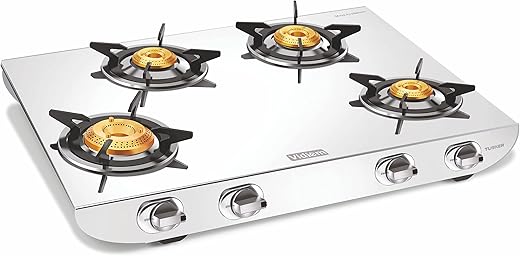
Vidiem Gas Stove S4 236 A Tusker (Black) | Stainless Steel 4 Burner frameless Gas Stove | Manual Ignition | Safety, Reliability, High Efficiency

1000w Hot Plate Charcoal Burner Sigdi Electric Stove Insant Coal Burner Coffe Maker, Boiling Water, Making Tea 5 minutes Coal Heater – Black

Thermador EcoFlame 4 Burner Gas Stove Glass Top Manual Ignition | Brass Plated Burners | Four Burner Gas Stove | LPG | ISI Certified | 1 Yr…
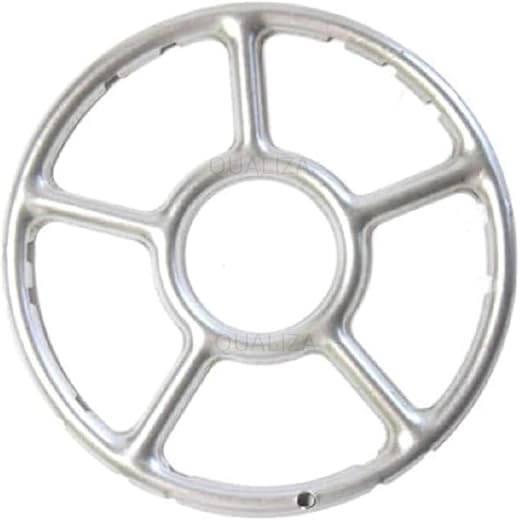
Gas Stove Burner Stand – Non-Slip Support Ring for Moka Pot, Pan, Wok & Coffee Pot | Gas Range Auxiliary Rack & Accessories | Kitchen Utensils (1)

Amazon Basics 2 Burner LPG Gas Stove with Toughened Glass-top | Tri-pin Brass Burners with spill-proof and easy-clean design | Ergonomic Knobs,…

Sunflame Diamond 3 Burner Gas Stove | 1 Medium and 2 Small Brass Burners | 2-Years Product Coverage by Sunflame | Heat Resistant Ergonomic Knobs |…

Prestige Svachh Neo 3 Burner Gas Stove | Easy Clean Design-3 Liftable Burners | Toughened Glass Top | Tri-Pin Brass Burners | 1 Jumbo Burner |…

Prestige Vectra 4 Burner Glasstop Gas Stove|Superior Toughened Glass|Jumbo Brass Burner|3-Way Gas Inlet|360 Degree Revolving Nozzle|10 Years…

Prestige Iris Plus 2 Burner Auto Ignition Gas Stove | Toughened Glass Top | Tri-Pin Brass Burners | Ergonomic Knob | Black | 2Y Warranty | ISI…

Sunshine Falcon Gas Stove | 3 Burner Chulha, Steel Gas Stove, Warranty By Sunshine – 5 Year On Burner, Manual Ignition | 5G technology, LPG (Silver)

Khaitan 3 Burner Draw Double Decker (with party cooking burner) Stainless Steel Manual Gas Stove (3 Burners)
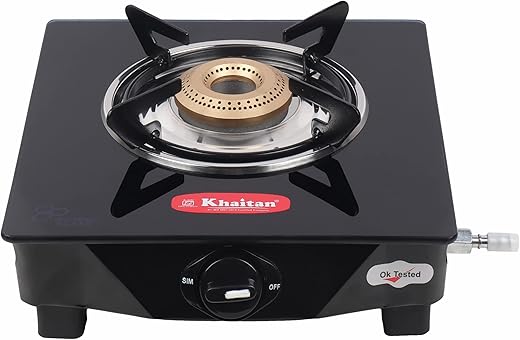
Khaitan 1 Burner BP Jio Black Toughened Glass | LPG Cooktop I Manual Ignition Stove| Ergonomic Knob|with 1 Year Warranty | Pan India Service| LP…
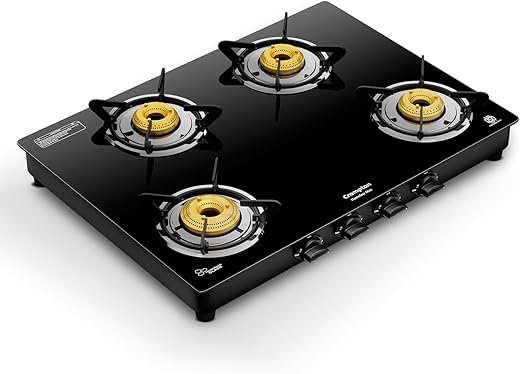
Crompton FlameStar Max 4 Burner Glass Top LPG Gas Stove | 1 Jumbo & 3 Medium Brass Burner | Max Space | Easy Cleaning | Toughened Glass| Tri Pin…
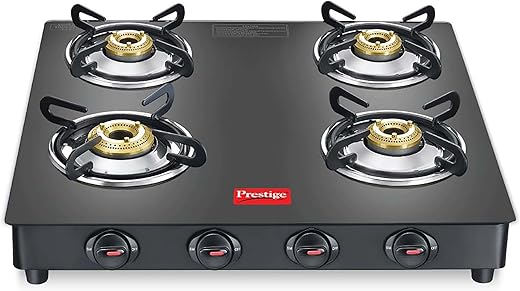
Prestige Magic Plus Gtmp 04 Sq Lp Open Gas Stove(Black, With Powder Coated Body, Glass Top And 4 U Brass Burners)

Faber Glass, Mild Steel Hobtop Utopia HT 804 BR CI Auto Electric Ignition Glass Top 4 Brass Burner (Black)
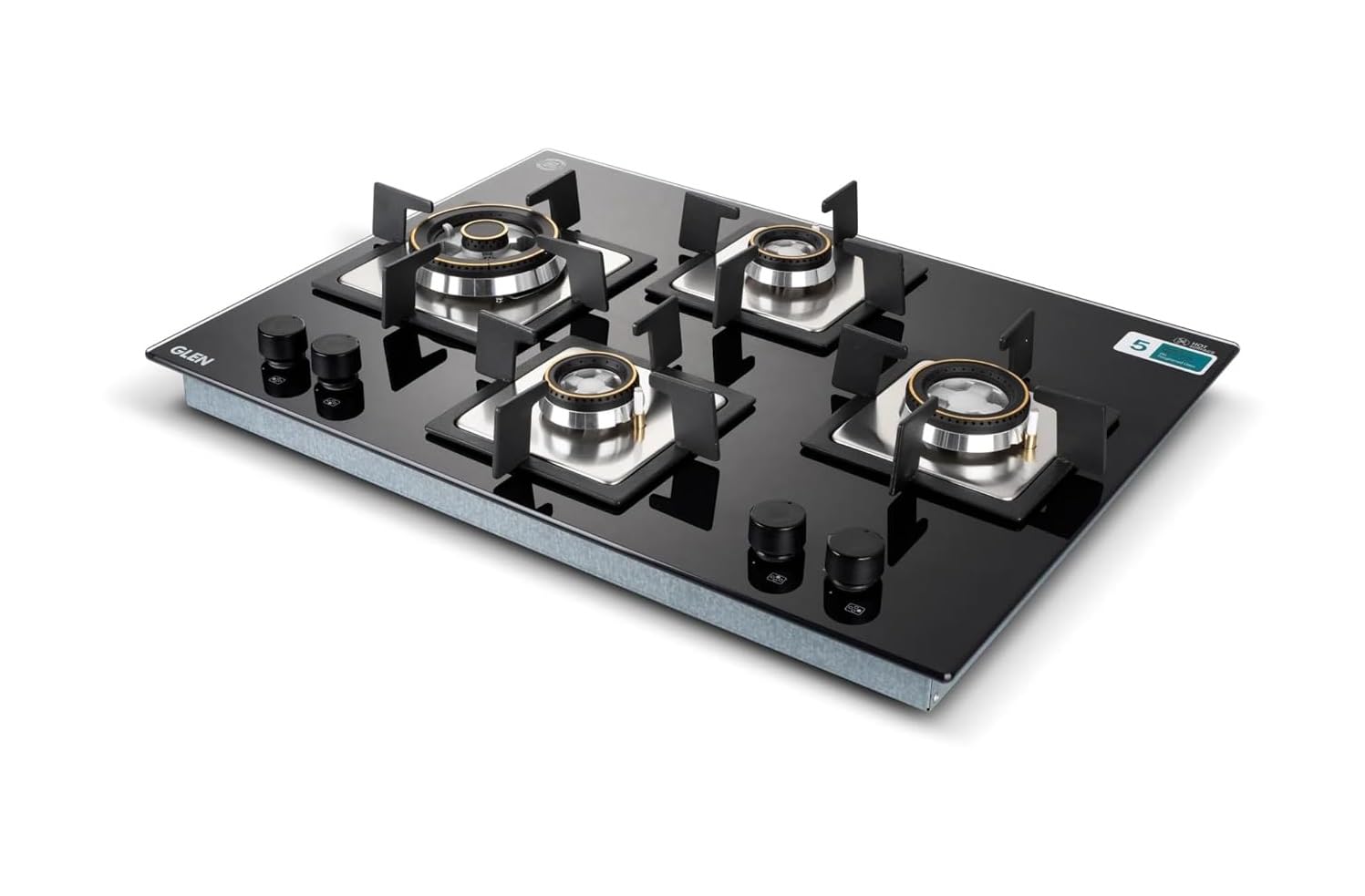
Glen Built In Hob 4 Burner Gas Stoves Auto Ignition 8 MM Toughened Glass Black Forged Brass Burner with Double Ring Flame Hob Gas Stove 4 Burner








